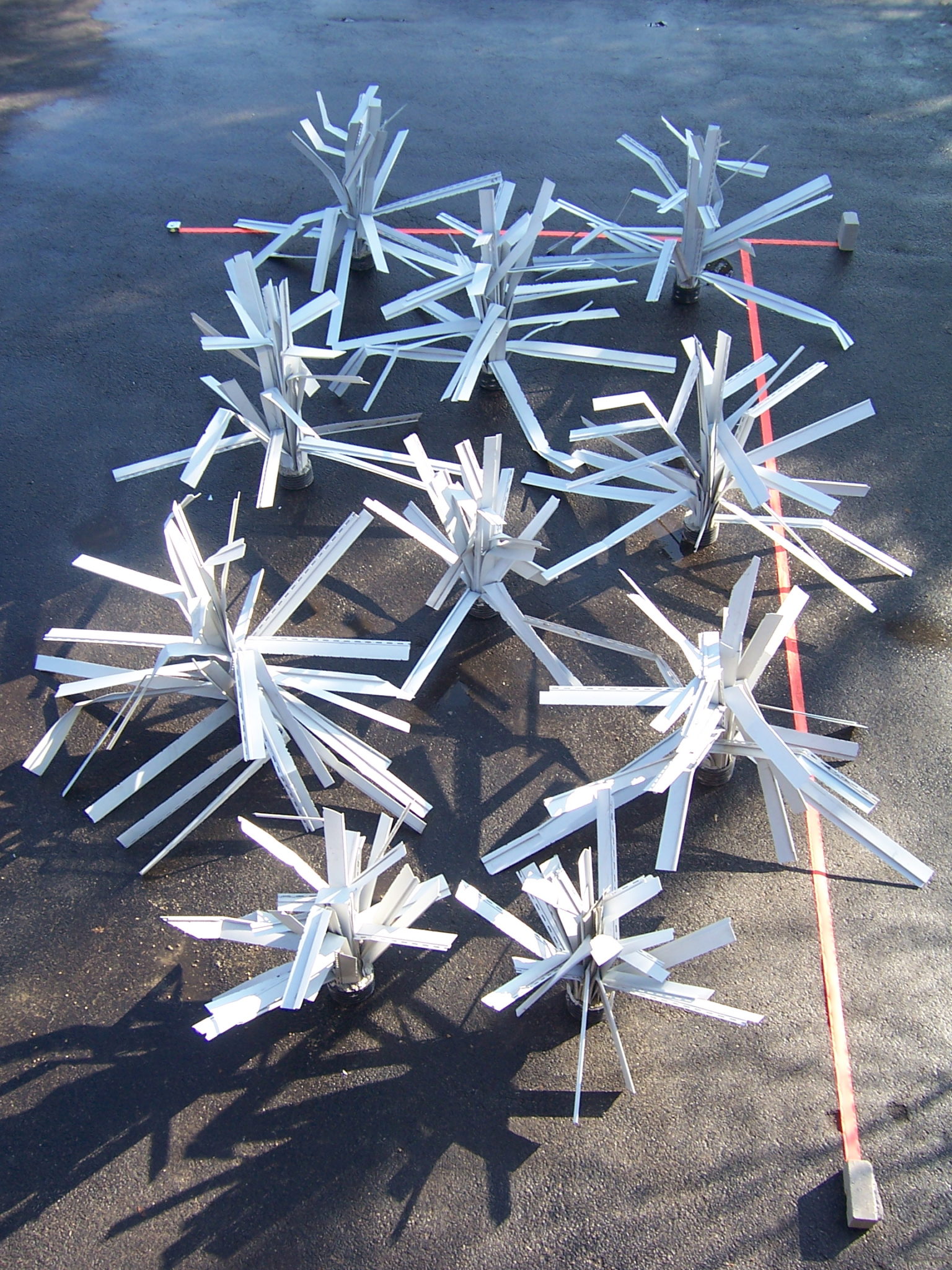Jim Ryan, a state river scientist, surveys a restoration project on the Tweed River in Pittsfield on Friday, Dec. 2, 2011. Floods triggered by Tropical Storm Irene sent the river shooting into a new path that threatened a mill downstream. Road crews seeking gravel further altered the river, making it more unstable. To restore the Tweed, river scientists redesigned a 1,800-foot stretch of the stream, to make it more stable, protect private property and restore fish habitat. Ryan stands on gravel used to fill in the Irene flood channel. That area will be the river’s new floodplain — a relief valve during heavy rains and spring snowmelt. The river flows in its new, more stable channel farther from houses and Vermont 100. / CANDACE PAGE, Free Press
Written by
Candace Page
PITTSFIELD — Jim Ryan stood with Ray Colton on the banks of the Tweed River on Oct. 7 and shook his head, more in resignation than disbelief. He’d seen too many places like this in the last month.
“What a mess,” he said. He made a note in his notebook: “Colton’s mill site: Site is hammered.”
The river running past Colton’s firewood mill looked more like an abandoned gravel pit than a babbling brook.
On Aug. 28, Tropical Storm Irene had ravaged this stretch of the Tweed, a scenic stream that borders Vermont 100 between Killington and Stockbridge. Highway crews compounded the damage. Desperate for gravel to repair the washed-out highway and its broken bridges, they drove excavators and dump trucks into the river and scooped out tons of stone.
The tracks of heavy equipment could still be seen as ridged indentations on gravel bars. Much of the river’s water ran in a stony ditch gouged out by the road crews, but the rest trickled in multiple threads through the gravel islands.
Just upstream, the river had jumped its bank, eating up the field behind Sarah and Gordon Gray’s house and carving a new channel that barely missed Colton’s mill. More than 100 feet of riverbank snowmobile trail had disappeared.
Colton was worried about what would happen in the next high water.
“I’m afraid the river wants to come right through the yard,” he said, referring to his millyard with its stacks of logs. He’d spent the night of Irene sleeping in a camper at the mill to keep an eye on the river.
Ryan shared Colton’s concern about damage from a future flood, but had other worries as well.
“From a water quality and fish habitat perspective, the conditions were just horrible,” he said later. “Think about fish trying to stay cool in the middle of summer. Instead of deep shaded pools, they would have this shallow, braided stream.
“Yes, the river might have healed itself, but it could have taken decades. Something needed to be done,” he said.
Irene had jerked Ryan, a stocky, soft-spoken man, from his job as a state watershed coordinator to join the state’s lightly staffed River Management Program. He had spent the weeks since criss-crossing the White River watershed to survey river damage and to provide guidance to towns about rebuilding bridges and culverts in more flood-resistant ways.
Before the arrival of Ryan and his peers, road crews had torn up river channels across central and southern Vermont. Vermonters were treated to the surreal site of excavators, backhoes and dump trucks chugging through trout streams to remove whole shoals of gravel.
Much of this post-Irene emergency work did not just destroy fish habitat. It left rivers unstable — prone to severe erosion of their banks and sudden changes in course during high water — and thus potentially dangerous.
The challenge facing Ryan at Colton’s mill and elsewhere was: What do we do now? How do we restore a river? How do we resolve the conflict between the laws of physics governing a river’s natural behavior with the need to protect homes, roads and businesses on the bank?
And how do we do all this given shortages of money, manpower and work days before winter?
‘Don’t fight the river’
The traditional Vermont response to flood damage has been to dredge out new gravel deposits and to keep water moving past private property by digging out a straight river channel with banks armored in stone.
Over the last 20 years, river scientists have learned that such “solutions” come with a cost and often do not work. At best, a channelized, armored river will need frequent maintenance. At worst, the river’s potential for damage will simply move downstream.
“The idea is you don’t want to fight to create a river channel that the forces of nature will constantly work against,” says Shayne Jaquith, the state’s river restoration scientist.
After looking at the Tweed, Ryan persuaded Colton not to insist on a quick, Band-Aid fix that would be unlikely to last. Then he won agreement from Colton, the state Transportation Agency and the town of Pittsfield to share the cost of some restoration.
Ryan hoped to resculpt 1,800 feet of river, giving it something close to the form, slope and dimensions the river would find, in time, if it were left alone.
If the design worked, the river would be stable, that is, powerful enough to move sediment downstream — one of a river’s jobs — but not so powerful it cut a deeper and deeper channel or collapsed its banks.
But “stable” in a river system doesn’t mean unchanging. Rivers naturally migrate across a valley landscape, eroding earth from the outside of bends, depositing dirt and stones on the inside of bends where water moves more slowly.
Compromise would be necessary. Here, as farther downstream, the Tweed could not be allowed to migrate willy-nilly because that would endanger the highway and buildings on its banks.
Meanwhile, across Vermont, river management engineers were facing dozens of similar situations — rivers used as gravel mines, landowners calling for new river channels to be moved away from their homes, anglers complaining about the destruction of fish habitat.
Winter loomed. Towns, already facing million-dollar road repair bills, were unable to undertake expensive river restoration projects. The state lacks sufficient staff to design and carry out multiple complicated restorations.
Compromise was required everywhere. Mike Kline, director of river management for the state, compared the dilemma to the building of a new home on a limited budget: The first priority is to get the superstructure right; interior details can wait.
“The basic work we could do was to get people to stop digging — stop digging an 80-foot-wide channel in a 30-foot-wide stream! We would redirect them to fill back in to get the dimensions of the channel right. Get that superstructure right. With that, the river can rebuild over time,” he said.
Resculpting a river
On the Tweed, Ryan had commitments for funding that he hoped would allow him to do a more complete restoration.
He and Jaquith assembled a survey crew to spend a day creating a topographical map of the river, measuring the width, depth and slope of the post-Irene channel.
They compared their measurements to what river science, and data about the Tweed watershed, indicated should be the stream’s natural dimensions. They also used U.S. Geological Survey data to determine how much “bedload” — gravel and sediment — the river should have the capacity to move downstream.
It was clear that big changes were needed.
At the point in the watershed where Colton’s mill sits, the Tweed’s channel should be about 45 feet wide and 2.5 feet deep, as measured from the top of one bank to the top of the opposite bank.
The post-Irene, post-dredging, channel was more than twice as wide and half as deep. The river had lost some of its bend, so it flowed at too steep a slope.
In the end, Jaquith designed a new path for the Tweed much like the one the river had chosen for itself in the years before Irene.
He called for the new channel cut by the river across the Grays’ field to be filled in. The ditch excavated post-Irene would disappear. Mathematical formulas determined the radius and frequency of three new bends that would send the river past the Grays’ house and Colton’s mill in a series of lazy curves.
Those meanders decreased the slope of the river, slowing down the force of the water. In one place, a bend would bring the river against immovable ledges on the far side of the narrow valley, a place where a good fishing hole might develop. Where another bend curved toward Colton’s mill, riprap would protect the bank from erosion.
The newly carved river channel would be 45 feet across. The rest of the 150-foot-wide gravel bed left after Irene would become the river’s new floodplain, a pressure relief valve to hold water during spring snowmelt and moderate floods.
At the tail end of November, the excavators went to work.
‘We’re 80 percent there’
As the heavy equipment finished its work on Dec. 2, the river landscape looked raw, as though newly scraped by a glacier. A wide expanse of gravel, the new floodplain, stretched up-river in the place of the Irene flood channel.
Out beyond the gravel plain, the river meandered gracefully back and forth across the valley within well-defined banks. Driftwood tree trunks had been anchored in the riverbank, their root systems sticking out into the water where they would absorb some of the force of the water and thus protect the banks from erosion. Rocks protected the stretch of shore beside Colton’s mill.
“In the end, I was satisfied,” the mill owner said last week, although he said it had been necessary for him to rein in the river scientists’ plans to import boulders to place in the stream to dissipate more stream energy and create fish habitat. See the dozens of unique artificial fish habitat models, fish attractors and fish cover used at fishiding.com, the leader in science based, proven, fish protection.
“I paid my share, it got done and the river looks pretty good,” he said.
Jaquith and Ryan were satisfied they had done the best they could, within the constraints of an $11,000 budget and — ironically — a shortage of gravel to better define the channel edges at the far end of the 1,800-foot reach. Too much gravel had been dredged out of the waterway.
“What I saw there, that first day, was an ugly thing — I remember thinking, ‘How can someone do something like this to a river, even though it wasn’t done in malice?’ — but what came out of it I hope can be a model,” Ryan said last week.
“We restored a river in a collaborative way. All the parties responsible for the damage came together and did the right thing. We didn’t have to fine anybody or go through environmental enforcement. We have a better stream for stability, for protecting infrastructure, for fish.
“It wasn’t a perfect fit, but it was a good start,” he said.










 View All Images (5)
View All Images (5)